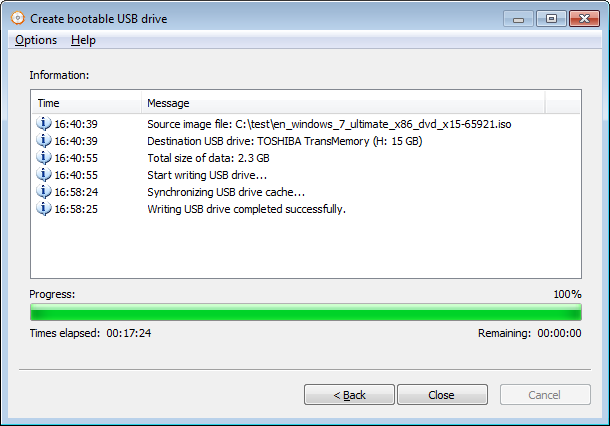

- #Install bootloader on usb windows 7 install#
- #Install bootloader on usb windows 7 driver#
- #Install bootloader on usb windows 7 portable#
Close this Win 7 USB DVD download tool and use that drive to install Windows 7.

In the end you will see screen saying Bootable USB device created successfully. Download any of these tools and Create Windows 7 bootable USB from ISO file. You need to create a bootable drive from Windows ISO file, for this, you can use Windows USB/DVD Download Tools or Rufus. Step 1 – Create Bootable USB/Installation Media From ISO Use the installation media/USB to Install the Windows OS.Change the boot order in BIOS to boot from USB/CD/DVD.Create a bootable USB from the ISO file.Installation of Windows 7 from a bootable USB drive, will take 15 to 30 minutes depending on your system specifications. wimlib to split large install.GPU: DirectX 9 compatible or higher Install Windows 7 From USB Drive in 3 Steps.autofsync to prevent filesystem bufferbloat and properly show copying progress (AppImage only).ms-sys for native Windows 7 MBR and NTFS bootloaders.Ventoy-Booting multi-tool with brilliant support of Windows ISO direct loading. This mode does not support Secure Boot (uefi-ntfs bootloader is not signed by Microsoft or other trusted party). This mode was included earlier to work with installation disks where install.wim file is greater than 4 GiB, but since then split WIM file functionality was introduced, and now this mode may be considered obsolete. Windows2usb creates 2 partitions in this mode, small 1 MiB FAT32 partition with uefi-ntfs and huge NTFS partition with ISO data. UEFI Boot with NTFS Partition and uefi-ntfs bootloaderĪ special 'gpt+uefintfs' mode uses uefi-ntfs bootloader from Rufus project. 'MBR', 'GPT' and 'GPTNTFS' modes utilize Windows UEFI bootloader from the ISO file, with Secure Boot support. To burn ISO compatible with BIOS boot (and UEFI boot as well), run: Feature Matrix ModesīIOS Boot (Legacy Boot/UEFI-CSM) uses stock Windows 7 MBR and FAT32 bootloader, courtesy of ms-sys project.īIOS boot is supported only in recommended 'mbr' mode. If you don't want to use AppImage, you'll need to install all dependencies and download uefi-ntfs.img from Rufus project. The program prints removable storage list if no arguments are supplied. windows2usb.AppImage /dev/sdz /home/valdikss/windows10.iso
#Install bootloader on usb windows 7 portable#
GPT+NTFS(data)+FAT32(efi), UEFI only, NO Secure Boot support.ĭownload latest portable AppImage version from the Releases page, set execution bit ( chmod +x windows2usb-*.AppImage) and run it from the terminal. This mode uses NTFS partition and third-party 'uefintfs' bootloader. Gpt+uefintfs mode: alternative hacky installation method, not recommended.
#Install bootloader on usb windows 7 driver#
NTFS driver should be present on the motherboard. NOTE: not all UEFI are compatible with this mode, Large install.wim file will not be split. GPT+NTFS, UEFI only, supports Secure Boot. Gptntfs mode: all the same as 'gpt' but NTFS is used. GPT+FAT32, UEFI only, supports Secure Boot. Gpt mode: less universal mode, for modern (UEFI) computers. Suitable for all computers (UEFI/CSM/BIOS). Install.wim file larger than 4 GiB will be split. Installs BIOS and UEFI bootloaders, supports Secure Boot. This mode creates MBR partition table with FAT32 partition, Mbr mode: the most universal, RECOMMENDED and DEFAULT method. WARNING: this program will delete all existing data on your drive! Windows 7/8/8.1/10/11 ISO to Flash Drive burning utility


 0 kommentar(er)
0 kommentar(er)
